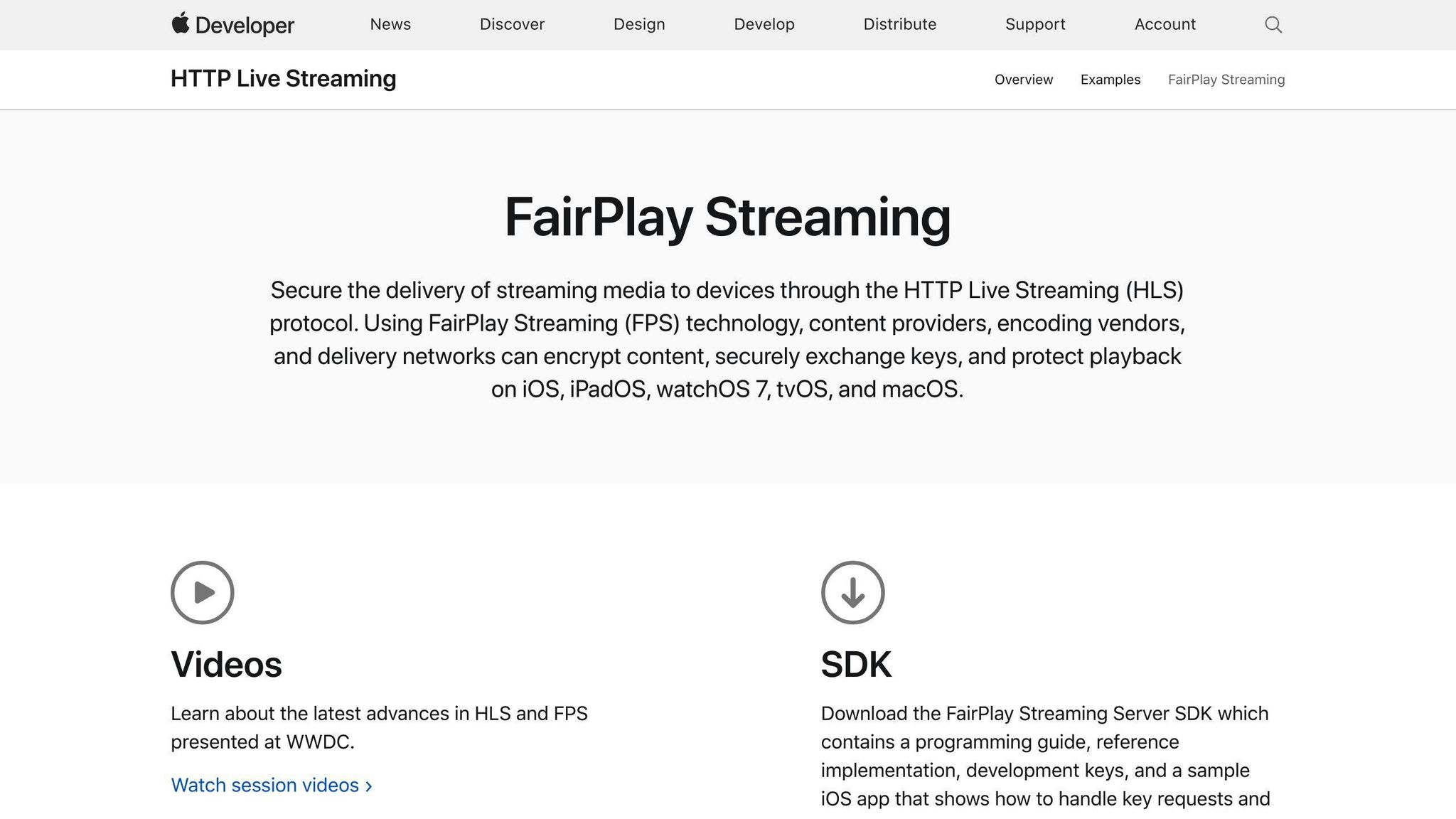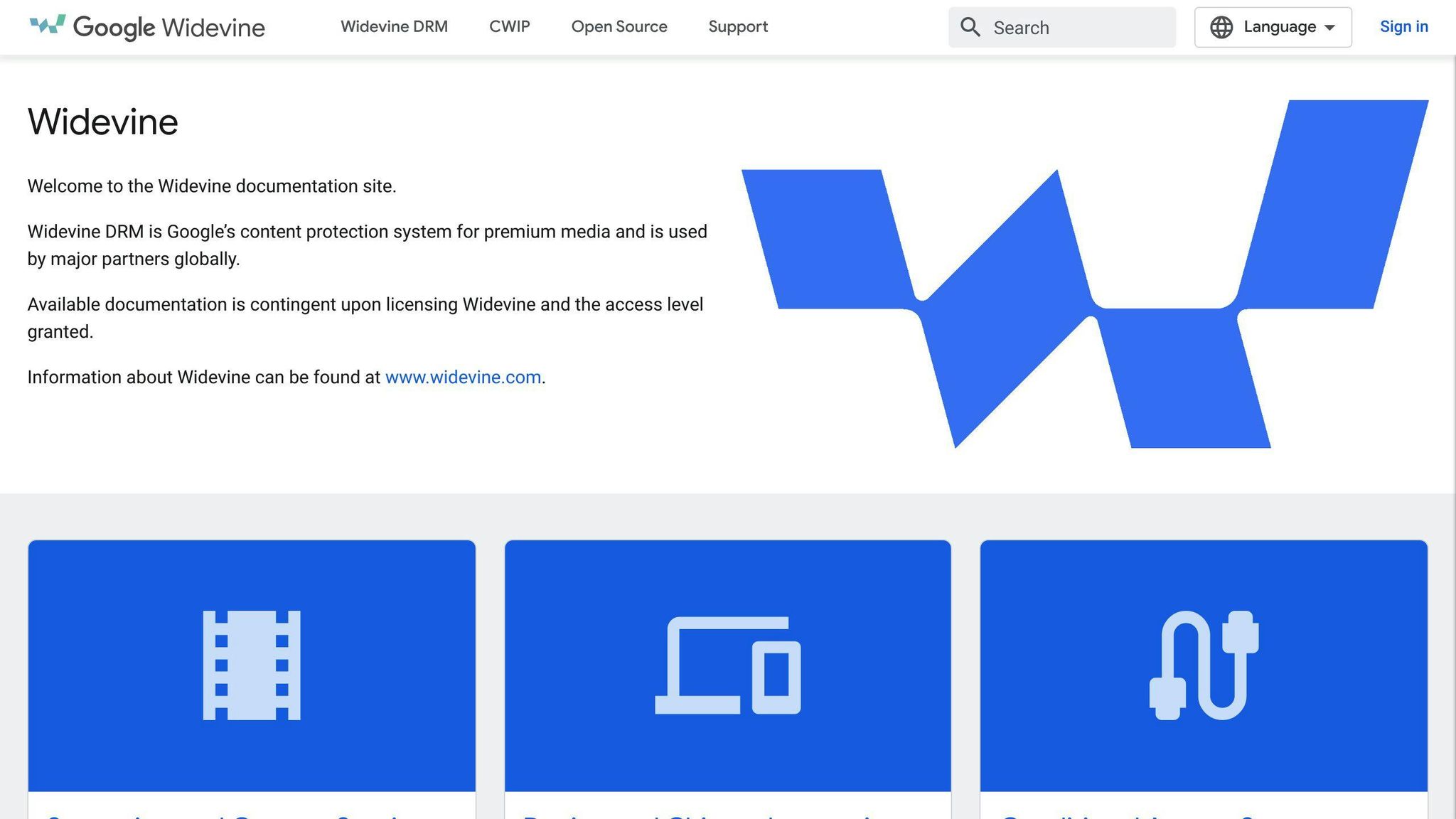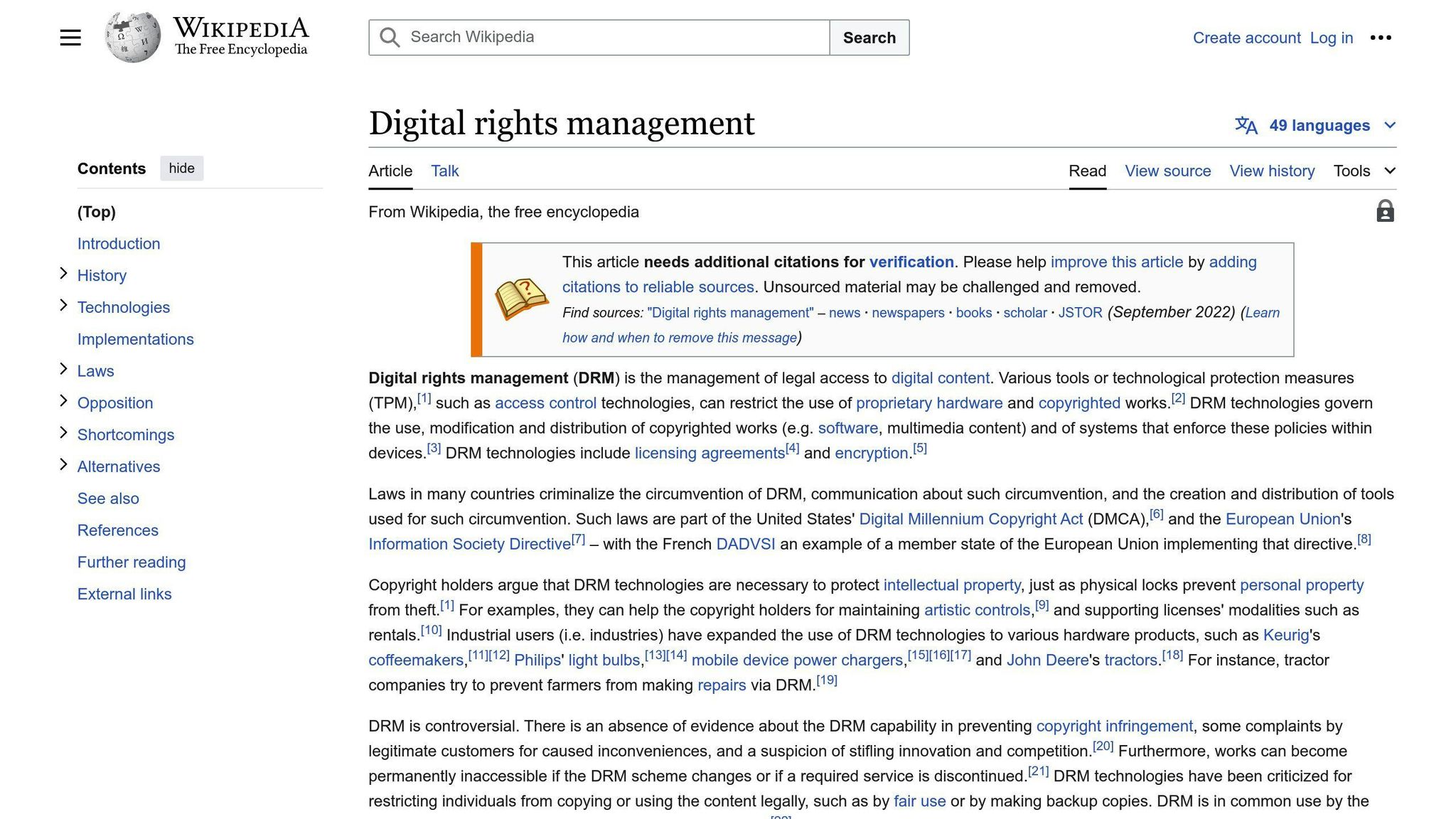Digital Rights Management (DRM) is a technology that controls how digital content like e-books, videos, music, and software is accessed and used. Its main purpose is to prevent unauthorized copying or sharing of copyrighted materials.
Related video from YouTube
How DRM Works
DRM encrypts digital content, making it unreadable without a decryption key. Users must obtain a license or key from the DRM system to access the content within specified limitations.
| Step | Description |
|---|---|
| 1 | Digital content is encrypted |
| 2 | User requests access |
| 3 | DRM system verifies user’s rights |
| 4 | If authorized, a decryption key is provided |
| 5 | User can access content within set limitations |
Benefits of DRM
| Benefit | Description |
|---|---|
| Protect Intellectual Property | Prevents unauthorized copying and distribution |
| Maintain Revenue Streams | Ensures content owners are compensated |
| Enable Business Models | Allows flexible pricing and distribution options |
Limitations of DRM
| Limitation | Description |
|---|---|
| User Experience | Can inconvenience legitimate users and limit fair use |
| Compatibility Issues | May not work across all devices or platforms |
| Circumvention | Determined individuals may bypass restrictions |
DRM is used in various industries like media, publishing, software, and gaming to protect intellectual property and maintain revenue. As technology evolves, DRM solutions must balance content protection with user experience and fair use.
Defining DRM
What is DRM?
Digital Rights Management (DRM) is a technology that controls how digital content like e-books, videos, music, and software is accessed and used. Its main purpose is to prevent unauthorized copying or sharing of copyrighted materials. With DRM, content owners can:
- Restrict access to their digital content
- Set time limits for access
- Limit the number of devices or users
- Track how the content is being used
Types of DRM Systems
There are different types of DRM technologies designed to protect various digital content:
- Encryption-based DRM: Encrypts the content, making it unreadable without a decryption key.
- Watermarking-based DRM: Embeds a unique identifier into the content, allowing tracking of its distribution.
- License-based DRM: Requires users to obtain a license or key to access the content, which can expire or be revoked.
- Cloud-based DRM: Stores content in the cloud and controls access through a cloud service.
These DRM systems are used in industries like media, publishing, software, and gaming to protect intellectual property and maintain revenue.
How DRM Works
Protecting Digital Content
DRM technology protects digital content from unauthorized access and copying. It does this through encryption and access control.
Encryption and Decryption
1. Encryption: The digital content is scrambled or encoded using an encryption algorithm. This makes the content unreadable without a special key.
2. Decryption: When a user requests access, the DRM system verifies their credentials. If authorized, it provides a decryption key to unscramble the content, allowing the user to view or use it.
Access Control and Licenses
| Step | Description |
|---|---|
| 1 | A user requests access to protected digital content. |
| 2 | The DRM system checks with a license server to verify the user’s credentials and permissions. |
| 3 | If authorized, the license server issues a license or decryption key to the user. |
| 4 | The user can then access and use the content within the specified limitations. |
This process ensures only authorized users can access the content, preventing unauthorized copying or sharing.
sbb-itb-738ac1e
Common DRM Technologies
DRM technologies play a key role in protecting digital content from piracy and unauthorized access. Here, we’ll look at three widely-used DRM technologies: Apple FairPlay, Google Widevine, and Microsoft PlayReady.
Apple FairPlay

Apple FairPlay is a DRM technology developed by Apple to protect its digital content, including:
- Music
- Movies
- TV shows
FairPlay uses encryption and access control to ensure only authorized users can access the content. It’s integrated into Apple’s ecosystem, providing a seamless experience for users on Apple devices.
Google Widevine

Google Widevine is a popular DRM technology used by major content providers like:
Widevine supports multiple platforms, including:
- Android
- iOS
- Chrome browsers
It offers various security levels, including software-based encryption and secure hardware execution environments.
Microsoft PlayReady

Microsoft PlayReady is a DRM technology developed by Microsoft to protect digital content on:
- Windows devices
- Xbox
- Other platforms
PlayReady supports multiple formats, such as:
- MPEG-DASH
- HLS
- CMAF
It offers robust security features, including encryption and access control. PlayReady is widely used in the media and entertainment industry to protect premium content.
| DRM Technology | Developed By | Platforms Supported | Key Features |
|---|---|---|---|
| Apple FairPlay | Apple | Apple devices | Encryption, access control, integrated into Apple ecosystem |
| Google Widevine | Android, iOS, Chrome browsers | Multiple security levels, software and hardware encryption | |
| Microsoft PlayReady | Microsoft | Windows, Xbox, other platforms | Supports various formats, encryption, access control |
These DRM technologies have unique features and platform compatibility. Content creators and distributors can choose the best DRM solution based on their specific needs.
Benefits of Using DRM
DRM (Digital Rights Management) offers several advantages to content creators, publishers, and distributors. By implementing DRM, they can protect their work, generate income, and comply with copyright laws.
Protecting Copyrighted Work
DRM safeguards the copyrighted materials of creators and publishers by encrypting digital content and controlling access to it. This prevents unauthorized copying, sharing, and distribution, ensuring that creators retain ownership and control over their work.
Generating Income
DRM enables content creators to generate income streams through controlled access and distribution. By setting up subscription models, pay-per-view, or timed access, creators can monetize their content. DRM also allows for flexible pricing options, enabling creators to cater to different audience segments and maximize earnings.
Copyright Law Compliance
DRM helps content creators and distributors comply with copyright laws and regulations. By implementing DRM, they can ensure that their digital content is protected from piracy and unauthorized use, thereby avoiding legal issues and potential fines.
Enhancing User Experience
While protecting digital content, DRM can also improve the user experience. By providing a secure way to access content, creators can enhance user engagement and satisfaction. Additionally, DRM can enable features like offline access, multi-device support, and personalized content recommendations, further enriching the user experience.
| Benefit | Description |
|---|---|
| Protecting Copyrighted Work | Safeguards creators’ ownership and control over their work |
| Generating Income | Enables monetization of digital content through controlled access and distribution |
| Copyright Law Compliance | Ensures compliance with copyright laws and regulations |
| Enhancing User Experience | Provides a secure way to access content, enhancing user engagement and satisfaction |
| Flexible Pricing Options | Allows for subscription models, pay-per-view, timed access, and flexible pricing |
Drawbacks and Challenges of DRM
While DRM offers benefits, it also presents some limitations that can impact the user experience, compatibility, and raise privacy concerns.
User Access Restrictions
One drawback of DRM is that it can limit how users access and use digital content they’ve purchased. By restricting access, DRM may prevent users from exercising fair use rights. For example, a user who buys a digital movie might not be able to watch it on certain devices or share it with family members. These restrictions can frustrate users, who may feel their rights are being unfairly limited.
Device and Platform Compatibility Issues
DRM software might not work across all devices and platforms. This lack of compatibility can cause significant frustration for users who expect to access their purchased content seamlessly on various devices. For instance, a movie bought on one platform might not play on another due to different DRM systems, leading to an inconvenient user experience.
Privacy Concerns
DRM can raise privacy concerns, as it may involve monitoring and tracking user behavior. This can lead to worries about data privacy and the potential misuse of user information. Additionally, DRM systems can be vulnerable to hacking or workarounds, exposing users to security risks.
Implementation and Maintenance Costs
Implementing and maintaining DRM systems can be costly and resource-intensive. Content creators and distributors must invest in DRM technology, infrastructure, and personnel to manage and update their DRM solutions. These costs can be prohibitively expensive, especially for smaller content creators or independent publishers.
Performance Impact
DRM can impact system performance, causing slow loading times or errors. This can lead to a frustrating user experience, especially for those with slower internet connections or older devices.
| Limitation | Description |
|---|---|
| User Restrictions | Limits how users access and use digital content, preventing fair use |
| Compatibility Issues | Doesn’t work across all devices and platforms, causing inconvenience |
| Privacy Concerns | Involves monitoring user behavior, raising data privacy and security worries |
| Implementation Costs | Requires significant investment in technology, infrastructure, and personnel |
| Performance Impact | Can cause slow loading times or errors, leading to frustration |
DRM in Various Industries
Media and Entertainment
DRM is used to protect copyrighted content like movies, music, and videos. Streaming services like Netflix, Hulu, and Amazon Prime use DRM to ensure only authorized users can access their content. For example:
- Apple’s FairPlay DRM protects movies and TV shows on iTunes.
- Google’s Widevine DRM protects content on Google Play.
Publishing
In publishing, DRM protects e-books and digital publications. Many e-book platforms, such as Amazon Kindle and Apple Books, use DRM to restrict access to e-books and prevent piracy. This ensures authors and publishers receive fair compensation.
Software and Gaming
Game developers use DRM to ensure only authorized users can play their games. Software companies use DRM to restrict access to their applications. This prevents piracy and protects software licenses.
Enterprise and Government
In these sectors, DRM protects sensitive documents and data. It restricts access to confidential documents, ensuring only authorized personnel can view or edit them. This helps prevent data breaches and maintains information integrity.
| Industry | DRM Usage |
|---|---|
| Media and Entertainment | Protect copyrighted movies, music, videos |
| Publishing | Restrict access to e-books, prevent piracy |
| Software and Gaming | Prevent piracy, protect software licenses |
| Enterprise and Government | Restrict access to sensitive documents and data |
The Future of DRM
Emerging Technologies and DRM
Blockchain is a promising technology for DRM. It provides transparent and tamper-proof records of content distribution and usage. Smart contracts can automatically enforce licensing terms, reducing overhead and improving security. Additionally, artificial intelligence (AI) and machine learning will enhance security and effectiveness in DRM solutions.
Balancing Protection and User Experience
Content creators and distributors must find ways to protect intellectual property without compromising user experience. This requires adopting technologies that protect content effectively while allowing fair use and ensuring compatibility across devices and platforms. By striking the right balance, DRM solutions can respect intellectual property rights while promoting productivity and innovation.
In the future, DRM solutions will need to adapt to trends like streaming services and mobile device usage for accessing digital content. By embracing innovations in DRM, businesses can ensure the integrity and accessibility of digital content, protect intellectual property, and promote a secure and collaborative ecosystem.
| Emerging Technology | DRM Impact |
|---|---|
| Blockchain | Transparent and tamper-proof records, smart contract enforcement |
| AI and Machine Learning | Enhanced security and effectiveness |
| DRM Consideration | Description |
|---|---|
| Content Protection | Robust protection of intellectual property |
| User Experience | Allowing fair use and device compatibility |
| Balanced Approach | Respecting rights while promoting productivity and innovation |
Conclusion
Digital rights management (DRM) plays a key role in protecting copyrighted digital content like e-books, movies, music, and software. As the digital content industry grows, it’s crucial to find a balance between protecting intellectual property and providing a good user experience.
In the future, technologies like blockchain, AI, and machine learning will enhance DRM security and effectiveness. Content creators, distributors, and users need to stay informed about the latest DRM developments.
| Technology | DRM Impact |
|---|---|
| Blockchain | Transparent records, automated license enforcement |
| AI and Machine Learning | Improved security and effectiveness |
| Consideration | Description |
|---|---|
| Content Protection | Safeguarding intellectual property |
| User Experience | Allowing fair use, device compatibility |
| Balanced Approach | Respecting rights while promoting productivity |
FAQs
What is a DRM problem?
A DRM problem refers to the restrictions and limitations imposed by Digital Rights Management (DRM) technology on how users can access and use digital content. DRM often prevents copying content or limits the number of devices it can be accessed from. Content creators may use applications to control what users can do with their material or encrypt digital media, which can only be accessed with a decryption key.
How does DRM work on ebooks?
For ebooks, DRM relies on encryption to protect the content. The ebook files are encrypted using robust algorithms, making the content unreadable without the proper decryption key. By encrypting the files, DRM prevents unauthorized individuals from accessing the ebook’s contents.
How does digital rights management affect multimedia content distribution?

DRM helps prevent unauthorized distribution of digital multimedia content like movies, music, and videos. It makes it difficult for users to copy or share the content without permission. DRM enables content creators to comply with copyright laws and prevent piracy of their digital content.
| DRM Impact | Description |
|---|---|
| Content Access | Restricts copying or limits devices for access |
| Ebook Protection | Encrypts ebook files to prevent unauthorized access |
| Multimedia Distribution | Prevents unauthorized copying and sharing of content |
| Copyright Compliance | Helps creators follow copyright laws and prevent piracy |

